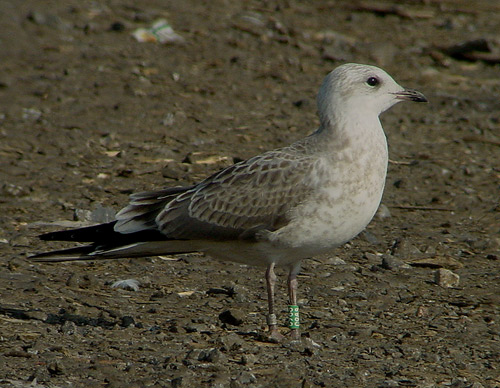 Mew Gull Larus canus canus; heinei; kamtschatschensis; brachyrhynchus
Mew Gull Larus canus canus; heinei; kamtschatschensis; brachyrhynchus
(last update: March 12, 2012)
Mew Gull canus 1cy C98S August 12 2002, Tampere, Finland.
A juvenile from mid August, ringed as pullus by Hannu Nyström at tampere, Finland (61.32N 23.52E) on June 29 2002. Most of the bird's plumage is still juvenile, but the first scapulars are moulted, replaced by plain grey second generation feathers. The new feathers can be found in the upper lower scapulars.

Mew Gull in juvenile plumage has the forehead, throat and nape white, with the ear-coverts and crown streaked. The streaks of the hind-neck often create a collar, running down the sides of the breast into mottled upper-breast and flanks. The belly and vent are white. In West European nominate canus, the upper-tail coverts and rump are white. The under-tail coverts are white as well, some with arrow-heads. The scapulars and mantle feathers are buffish-brown centred with a pale fringe, creating a scalloped effect. The tertials and inner three or four greater coverts are brownish centred as well, with a pale buff fringe. The central and outer greater coverts are more extensive grey-brown, although the feathers have dark shafts and wedge-shaped centres. The median coverts, lower lesser and lesser coverts have brown centres, a dark shaft and buffish fringe, creating a dark carpal bar, contrasting with the pale greater coverts. The dark secondaries create another dark bar on the upper-wing. The secondaries have a white trailing edge, running further onto the inner five primaries. The four to five inner primaries show pale inner-webs; the outer primaries and primary-coverts are all dark. The axillaries and under-wing coverts are white based with black tips, creating lines over the under-wing.